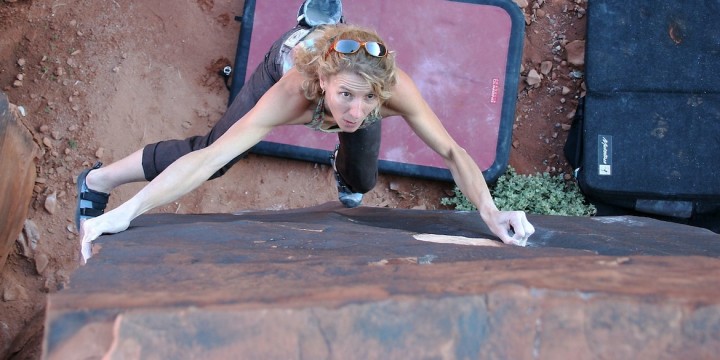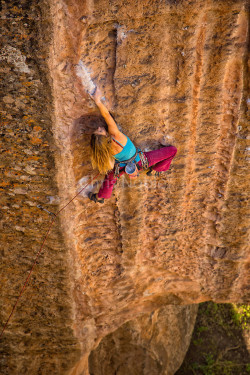
Climbing Bicep Injury
Hi Steph,
Recently, while googling on climbers injuries regarding my biceps injury, I bumped into one of your posts that you re-addressed to Lisa Hathaway on shoulder injuries back in January 2012. In her answer she mentioned that she once recovered from a biceps tendonitis/tendonosis.I’m struggling with a biceps distal insertion tendinitis and, eventually, tendonosis since September and I was wondering if you could pass the message to her once again and maybe she can advice me on how to get rid of that thing. I live in Argentina and health care isn’t that good, at least for climbers – not a lot of medics specialising in that kind of stuff, so I would really appreciate any tip at all, besides what I’ve already got from the post.
Thank you very much in advance, you have an amazing blog!
Artur

Hi Artur, here’s what Lisa says:
While I’ve never determined definitively if my (recurring, it still likes to rear its ugly head, especially with high-intensity, “slappy” bouldering) bicep problem is an -isis/osis or a fasciitis (and I’m not sure it even mattered. Actually, in hindsight I am certain it didn’t actually matter in my case), I was able to recover—and now manage recurrences—with some pretty simple steps.
Personally, I am still an advocate for the use of “ice” (frozen gel bags, not actual ice) and heat in both acute and persistent issues.
Here’s a small, but relevant aside: In the old days, for injury treatment, all the advice was RICE: Rest, Ice, Compression, Elevation.
Nowadays, the chatter leans to MEAT: Movement, Exercise, Analgesia, and Therapy
I won’t go into the back-and-forth on the topic—there is plenty of discussion and disagreement out there in both the peer-reviewed medical journals world and the anecdotal accounts world—but I do say, “Why not have the best of all worlds?!” I like HICEMEAT, H for heat. (Hint about my biases: rest is not my favorite thing!! ;))
So FOR ME (emphasis on FOR ME) the process that worked well was, and remains:
1.) I warm the affected area with a heat source (e.g. a sooting sack) prior to exercise and warm up thoroughly—WAY more thoroughly than you might ordinarily;
1a.) If camping I massage with The Super Salve Company Arnica Muscle Easing Salve (A miracle analgesic IMO!, for everything from shredded skin to -osises and muscle strains);
2.) When recovering, or if I sense a flare-up (for instance anytime I plan to climb on Big Bend’s Hellybelly boulder!), I take one or two of the plant based anti-inflammatory called zyflamend (you can find plenty of controversy on the topic of prophylactic anti inflamms—I’ll leave that debate to you, dear readers, I can only say what works for me and what I am comfortable with!);
3.) During and after activity I integrate light and gentle yoga-esque arm stretches and I would do more light stretching after the activity;
4.) Following activity I would wrap my bicep in a frozen gel bag (Tip: you can often get produce freezer bags free at natural grocers and these are perfect as they won’t freezer-burn your skin) and take additional Zyflammend. I might go through two or three freezer bags on a “bad” night;
5.) I would consider a traditional NSAID if feeling bad (my choice is always Naproxen Sodium).
6.) More massaging of the affected area with the SSC Muscle Easing Salve (contains Arnica, Wintergreen Cayenne, amongst other things);
7.) This is the trickiest one: mix up your routine. If you love climbing steep, blocky jugs, like those in Rifle Mountain Park, the site of my first flare-up, be sure you find footsie/slabby routes or days to mix into the routine. It may not be the time to frantically sesh a route or style you are possessed by—the project will wait. Trust me, they actually do. Sometimes for years … but that is another discussion …
One thing about recovery to bear in mind is that many think we “know” what works, like we know that z follows y follows x, but what works(ed) for me is not exclusive to other tactics someone else may reveal. I couldn’t really accurately experiment on myself—no one can—as we are not petri dishes in controlled environments with controlled variables and therefore no results are definitive! I can not emphasize enough the words “FOR ME”, followed by the caveat I am no doctor or medical professional at any level—just a life-long sportsaholic who has been injured and repaired. Manyyyy times. The one thing I would say, and say regularly to anyone with a persistent condition or recovering injury is “run/climb/cycle/etc through irritation, never through pain!” If you can do the above and not feel worse, chances are you might get better. Maybe no faster than with total restriction—possibly even slower—but with a happier head and heart because you are doing what you love!
Coincidentally, on this past Friday, I received a message from my friend Rachel, also suffering form an -itis/osis. We chatted and I recommended the same course to her. I didn’t think much about it in regards to this post, because I was thinking “shoulder”, as she described it, but I still had the same recommendation with the baseline being “run through irritation, never pain.” As it turns out, her diagnosis is also bicep related. Her initial diagnosis was “Bicep Tendinopathy, SSC Tendinopathy and potentially posterior labral tear.” (It sounds like after clinical eval, the tear is no longer suspected, or not considered significant.) So she is a few days up on this course of action and it seems to be suiting her. Here is an update from our chats.
Like most of us, she had a concern between “trying to find the correct balance between pushing it climbing and not making it too pained.” She also notes that the attended PT sessions make it angry, too. “Pain isn’t super bad and it’s mostly [painful] when I’m not climbing [I had the same experience]. I’d say after 1–2 hard pitches (she climbs 5.13 sport regularly, at the Red) I can’t do any more.” (Note: I wish I had that *problem* on a good day !!! ;)) Pressed on irritation vs. pain, she says she thinks it errs to irritation. This has been on-going for two-and-a-half months, with several 1–3 week hiatuses. So she has taken now to experimenting with the HICEMEAT. Here’s her update, bear in mind only a few days in, but I reckon we can post more as she progresses.
“I realized today that climbing on it doesn’t actually increase pain “in the moment”. Granted, I’m mentally not allowing myself to do full extension, off balance, Or feet-cut moves to the left arm… [Note the good advice! Proceed with caution and restraint if you choose to remain climbing through any injury or condition!] BUT there are plenty of hard moves I can do with my feet on in balance using the left arm with no increased in the moment pain. This was of course thanks to u pushing me to stop being scared to climb on it.”
Again, all disclaimers in place, I’m not a doc, she’s experimenting with herself based on treatment from an experiment with a sample size of one and is a very experienced, life-long athlete with a good sense of pain vs irritation! She is also now happier and not feeling worse, so this is encouraging for others in similar states to carefully experiment with this tactic.
Lisa








Thanks for posting! I’m dealing with this right now…
[…] #3: This article from Steph Davis (https://stephdavis.co/blog/climbing-bicep-injury/) is super informative and great at laying out what worked well for her. I also think that depending […]